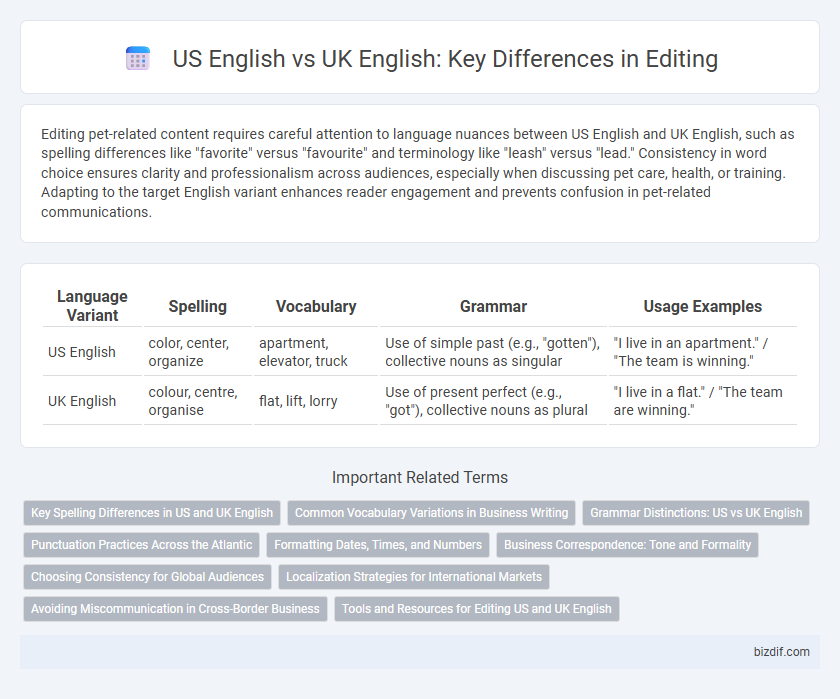Editing pet-related content requires careful attention to language nuances between US English and UK English, such as spelling differences like "favorite" versus "favourite" and terminology like "leash" versus "lead." Consistency in word choice ensures clarity and professionalism across audiences, especially when discussing pet care, health, or training. Adapting to the target English variant enhances reader engagement and prevents confusion in pet-related communications.
Table of Comparison
| Language Variant | Spelling | Vocabulary | Grammar | Usage Examples |
|---|---|---|---|---|
| US English | color, center, organize | apartment, elevator, truck | Use of simple past (e.g., "gotten"), collective nouns as singular | "I live in an apartment." / "The team is winning." |
| UK English | colour, centre, organise | flat, lift, lorry | Use of present perfect (e.g., "got"), collective nouns as plural | "I live in a flat." / "The team are winning." |
Key Spelling Differences in US and UK English
Key spelling differences in US and UK English often revolve around suffixes, with US English favoring -ize (organize) while UK English frequently uses -ise (organise). Words ending in -our in UK English, such as colour, simplify to -or in US English (color). Additionally, UK English tends to retain the double consonants in verbs when adding suffixes (travelling), whereas US English typically drops one consonant (traveling).
Common Vocabulary Variations in Business Writing
Business writing in US English often uses terms like "manager," "resume," and "email," while UK English prefers "manager," "CV," and "e-mail." Spelling differences also arise with words such as "organization" (US) versus "organisation" (UK), and "analyze" (US) versus "analyse" (UK). Understanding these vocabulary variations is essential for clear communication and professionalism in international business contexts.
Grammar Distinctions: US vs UK English
US English grammar often favors the use of the simple past tense, while UK English tends to prefer the present perfect tense for recent actions. In punctuation, US English typically places periods and commas inside quotation marks, whereas UK English places them outside unless they are part of the quoted material. Spelling differences also affect grammar rules, such as using "gotten" in US English versus "got" in UK English as the past participle of "get.
Punctuation Practices Across the Atlantic
US English typically uses periods and commas inside quotation marks regardless of logic, whereas UK English places punctuation according to whether it belongs to the quoted material. In British English, punctuation such as periods and commas appear outside the quotation marks unless part of the original quote, reflecting a more logical approach. These differences in punctuation practices influence editing strategies and require careful attention to style guides like the Chicago Manual of Style for US English and the Oxford Style Manual for UK English.
Formatting Dates, Times, and Numbers
In US English, dates are formatted as month/day/year (e.g., 04/27/2024), while UK English uses day/month/year (e.g., 27/04/2024). Time notation differs with US English favoring 12-hour format with AM/PM indicators, contrasted by UK English's preference for the 24-hour clock in formal contexts. Numerical formatting also varies; US English uses commas as thousands separators and periods for decimals (e.g., 1,000.50), whereas UK English commonly reverses this or excludes commas in some formal writing.
Business Correspondence: Tone and Formality
US English in business correspondence often favors a direct, concise tone with moderate formality, reflecting a preference for clear, actionable communication. UK English typically employs a more formal, polite style, using indirect phrasing and courteous expressions to maintain professionalism and respect. Understanding these differences improves cross-cultural communication and ensures appropriate tone and formality in international business exchanges.
Choosing Consistency for Global Audiences
Maintaining consistency between US English and UK English is crucial for clear communication in global audiences, ensuring that spelling, grammar, and vocabulary align with the target demographic's expectations. Editors must choose one variant and apply it uniformly across all content to avoid confusion and enhance professionalism. Adherence to style guides such as the Chicago Manual of Style for US English or the Oxford Style Manual for UK English supports this consistency in international publishing.
Localization Strategies for International Markets
Effective localization strategies for international markets require adapting content from US English to UK English by addressing spelling differences, vocabulary variances, and idiomatic expressions to resonate with target audiences. Attention to region-specific terminology, punctuation conventions, and grammatical preferences enhances clarity and engagement in localized materials. Utilizing localization tools and style guides ensures consistent application of US-to-UK English adaptations, optimizing communication effectiveness across diverse English-speaking markets.
Avoiding Miscommunication in Cross-Border Business
US English and UK English differ in spelling, vocabulary, and grammar, which can lead to misunderstandings in cross-border business communications. Ensuring consistent language usage and clarifying terms like "billion" or "schedule" prevents costly errors and fosters clearer collaboration. Editors must adapt content to the target audience's version of English to avoid ambiguities and enhance professional communication.
Tools and Resources for Editing US and UK English
Editing US English and UK English requires specialized tools and resources to ensure accuracy and consistency. Software like Grammarly and ProWritingAid offers settings to switch between US and UK English spellings, grammar rules, and punctuation styles. Style guides such as the Chicago Manual of Style for US English and the Oxford Style Manual for UK English provide essential references for editors working with regional language variations.
US English vs UK English Infographic

 bizdif.com
bizdif.com